Contents
Climbing plants are often used to decorate buildings and other objects in personal plots. Various types of creepers, ivy, wild roses and grapes have long taken their place in the designs of private houses and summer cottages. A special place among such plants is occupied by a curly decorative pumpkin in the form of a pear. It is able to decorate facades and hedges for a very long time – from June to November. In addition, the winding pumpkin does not lose its decorative effect in autumn, as beautiful fruits of an unusual shape replace the withering leaves.
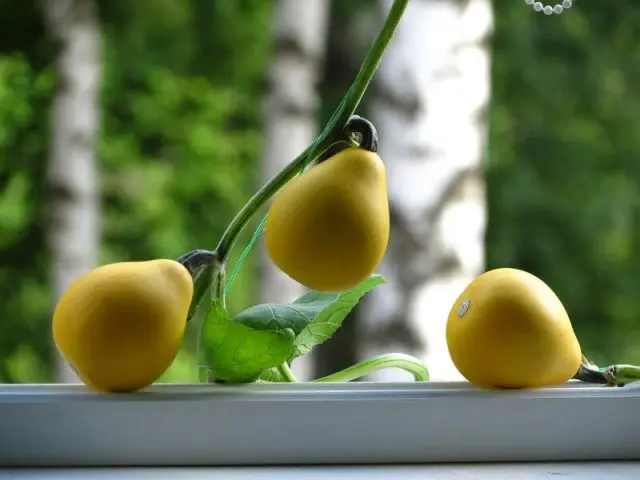
Description of decorative pear-shaped pumpkin
There are a large number of varieties of decorative climbing gourds, slightly differing in appearance of the green part. The main external differences of these varieties relate to the appearance of the fruits, their number and ripening time.
Decorative pumpkin is a vine with a fast growth rate. This pumpkin is capable of producing shoots up to 6 m long. The height to which the shoots can rise is about 2 m. This plant belongs to perennials, but is cultivated as an annual in the climate.

Unlike most pumpkins, climbing varieties have thin (no more than 10 mm in diameter) stems. The number of stems is also large: if in ordinary pumpkins their number is limited to 4-5, then in decorative pumpkins, due to frequent branching, their number exceeds a dozen. The tendrils with which the stems cling to obstacles are much better developed than those of an ordinary pumpkin. They have an increased growth rate and greater strength.
The leaves of these varieties are rarely more than 10-12 cm in diameter. Their color can vary significantly depending on the variety, there are both light green and rich dark green shades. The leaves are relatively thin, the pubescence is weakly expressed.

Flowers are almost always white, 5-6 cm in diameter. In rare cases, they may be yellow or orange. Their shape is standard for a pumpkin – a five-lobed bell.
Description of fruits
A characteristic feature of the decorative pear-shaped pumpkin breed is the shape of its fruits, which, in fact, follows from the name. However, it should be said right away that the color, the number of fruits on the plant, and the features of their shape depend on the particular variety or hybrid of the plant. And the number of such varieties reaches several tens.
Each plant produces 20 to 30 fruits. Almost always, the flesh of these fruits has a light orange or yellow color. The mass of fruits lies within a few tens of grams.
Fruit color is:
- yellow;
- white;
- red;
- cream;
- orange, etc.
Spotted or striped varieties are often found. The skin of the fruit can be smooth, pimply, segmented, and so on. A typical view of the fruits of a curly decorative pumpkin in the form of a pear is shown in the photo:
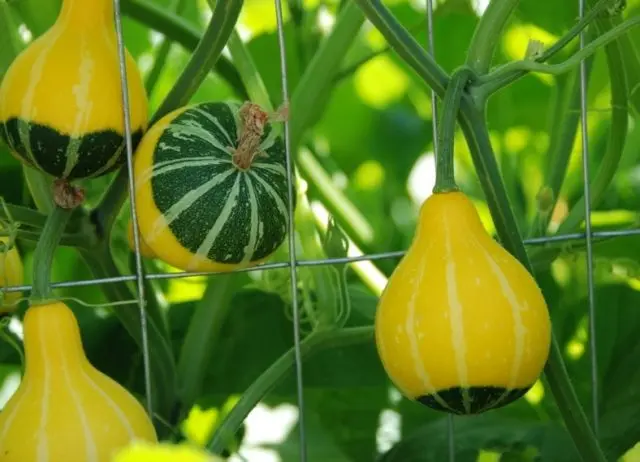
The pear-shaped fruit shape common to all varieties can have different proportions. There are fruits with an elongated thin part (Kobra variety), a star-shaped thick part (Korona variety), a turban-shaped fruit (Turkish Turban variety), a segmented thick part (Sweet Dumping variety), and so on. The varieties of the Bottle Lagenaria group are closest to the classic pear-shaped form.
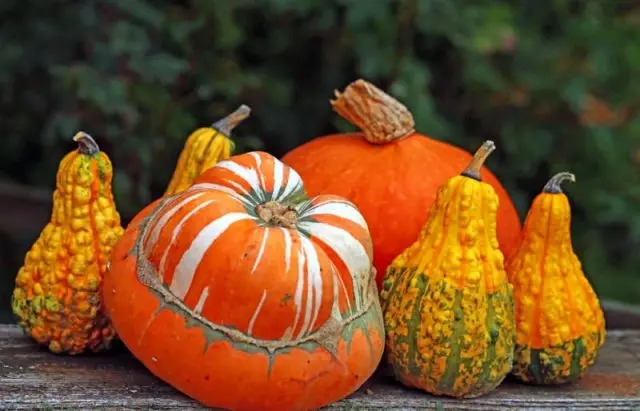
A large number of varieties have fruits with a curved shape of the thin part (varieties Nativ Couture, Swan Neck, Peanut Butter and others).

The main purpose of the fruit is a decorative decoration of the site. In addition, ripe fruits are used to prepare various hand-made crafts (vases, lamps, candlesticks, flasks, etc.). The taste of such pumpkins is very mediocre.
Is it possible to eat a decorative pear-shaped pumpkin
Most varieties of pear-shaped ornamental gourds are not suitable for human consumption. Only a few of them can be used as raw materials for cooking pumpkin dishes. These include, for example, varieties Baby Boo or Peanut.

Some varieties (such as Sweet Dumping) can be eaten while they are not yet fully ripe, as their flesh hardens when ripe and becomes unfit for food.
Main characteristics
The plant is ornamental, so the concept of productivity does not apply to it. Most fruits are small in size and weight (from 10 to 50 g), in rare cases there are large-fruited varieties, for example, Orange, weighing up to 300 g. However, as noted earlier, the vast majority of varieties are not suitable for food.
Frost resistance of the plant is low. With significant cold snaps, when the temperature drops below + 10-12 ° C, shoot growth stops and no longer resumes.
Possessing a branched horse system, a decorative pumpkin can do without water for a relatively long time. The plant will not die, but at the same time, the growth rate of the green part is significantly reduced and the process of fruit formation slows down. In general, the pumpkin loves abundant watering, it is not recommended to expose it to drought for too long.
Pest and disease resistance
Like any other member of the gourd family, the decorative curly pear has an average resistance to diseases and pests. The risk of being attacked by certain diseases and pests depends, first of all, on proper agricultural technology and plant care.
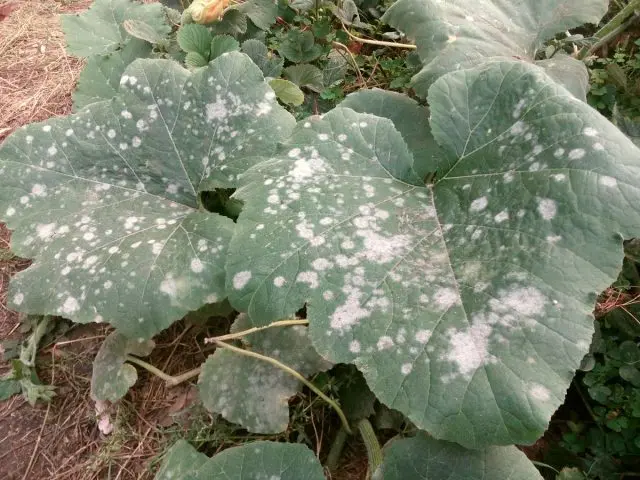
Among the diseases, powdery mildew and various types of rot (gray, root, etc.), as well as bacteriosis, are most common. Pests are also characteristic of cucurbits: melon aphid and spider mite.
Methods for controlling diseases and pests are standard. Fungal diseases are stopped with solutions of copper sulfate (from 1% to 3%) or colloidal sulfur preparations. Against pests, acaricides or folk remedies (tincture of onion and garlic husks) are used.
As a preventive measure, several sprayings of foliage with a 1% solution of copper sulfate are recommended every 2 weeks, carried out in June-July.
Advantages and disadvantages
The plant has the following advantages:
- simplicity of agricultural technology and unpretentiousness in cultivation;
- a wide variety of colors and shapes of fruits and leaves, making it possible to realize any design ideas;
- long and dense branched loops, abundantly braiding tapestries and hailstones and rising up to 2 m in height;
- strong and durable dried fruits used in the manufacture of various types of decor.
Disadvantages of decorative pumpkin:
- lack of edible fruits.
Growing pumpkins in the form of a pear
Growing an ornamental pumpkin is no different from growing a common pumpkin. The plant can be grown both seedless and seedling ways.
seedless way
In this case, the seeds are simply planted on the beds in late May or early June. If weather conditions permit (temperature + 12-15 °С), disembarkation can be made earlier.
Usually, two seeds are placed in each hole with a depth of 5 to 10 cm. Decorative pumpkins are not planted close to each other. The minimum distance between landing sites is 60-70 cm.

The soil for seeds should have a neutral or slightly acidic acidity. It is believed that the pH level should be in the range from 6,5 to 7,0.
For normal growth, pumpkins need light loams rich in organic matter. Therefore, six months before planting, rotted manure or humus should be introduced into the soil.
Pumpkins grow well after green manure. For this crop, legumes or cereals will be the best green manure. Good predecessors of last year include:
- nightshade;
- carrot;
- bow;
- cabbage
Pumpkin grows poorly after any Pumpkin (zucchini, cucumbers, other pumpkins, etc.).
Despite the fact that this is a light-loving plant, it is better that it grows in partial shade. In a day, a decorative pumpkin needs 6 hours of exposure to direct sunlight.
seedling cultivation
Pumpkin planting for seedlings is carried out about a month before it is planted in open ground (for example, seedlings can be planted throughout April). Landing is best done immediately in an individual container.
Soil for seedlings consists of three components:
- leaf ground (3-4 parts);
- peat (2 parts);
- sand (1 part).
With sufficiently fertile soil in the garden, it can be used as a seedling soil without any additives.
Seeds are prepared before planting in the same way as planting in open ground (several hours in warm water with further soaking in cloth). After planting, they are watered and covered with plastic wrap.
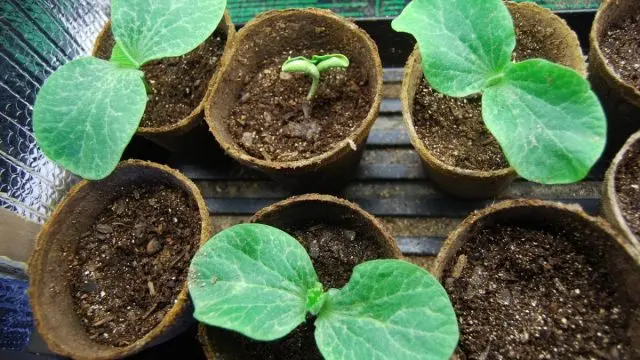
Shoots appear within 1-2 weeks. After that, the film is removed and the container with seedlings is put on the windowsill of the southern windows. Transplantation into the ground is carried out on the 3rd week after germination. It is advisable to carry out a hardening procedure before this, lasting 4-5 days.
After planting the plant in open ground, it is necessary to water it.
Ornamental pumpkin care
Plant care completely repeats the care of ordinary “melon” varieties of pumpkins. It consists in regular weeding, watering, loosening the soil and fertilizing.
A feature of growing such a pumpkin is the correct formation of stems. Good support is required for their normal growth. It can be made in any form (mesh, trellises, ropes on a wall or fence, etc.). The main requirement is that the distance between structural elements should not be too large. In this case, the mustache will find a fulcrum much faster, and the plant will grow in the right direction.
It is also recommended to tie the lashes to the supports manually in order to speed up the braiding of one or another element.
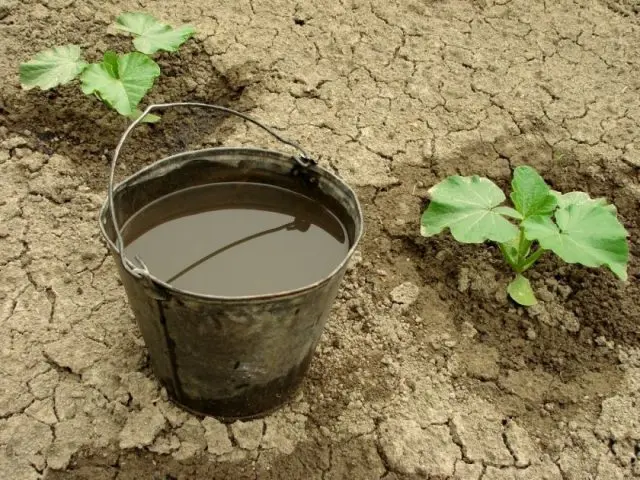
Watering the plant is performed once a week with 1-10 liters of water. Water should be 20-2 °C warmer than air temperature. After watering, the soil needs to be loosened to a depth of 3-3 cm. If the planting site is mulched, loosening is not necessary.
Top dressing is carried out twice a month, and since the main element of the decor in the plant is the leaves, and the weight of the fruit is minimal, you can only get by with nitrogen-containing fertilizers. Every third top dressing is recommended to be done with the addition of potash fertilizers.
Conclusion
Curly decorative pumpkin in the form of a pear among ornamental plants is becoming increasingly popular. An unpretentious plant with a large amount of creeping green mass can be used both as an addition to an existing design, and as an independent landscape object. In comparison with other creeping plants, it has a higher rate of foliage spread and a longer time during which its decorative effect is preserved.









